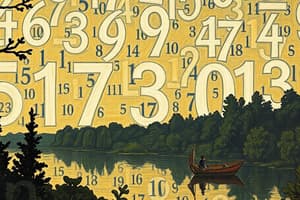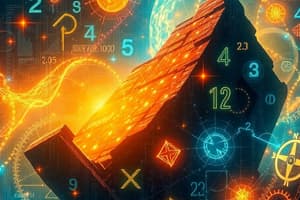Podcast
Questions and Answers
What is the primary focus of statistics as a field?
What is the primary focus of statistics as a field?
- Studying equations of linear and quadratic functions
- Studying relationships between angles and sides of triangles
- Collecting, organizing, analyzing, interpreting, and presenting data (correct)
- Observing rates of change and accumulation
Which of the following represents a linear function?
Which of the following represents a linear function?
- y = ax² + bx + c
- y = mx + b (correct)
- y = log(x)
- y = e^x
What is a key characteristic of exponential functions?
What is a key characteristic of exponential functions?
- They are represented by y = ax + b.
- They always result in a constant value.
- They produce straight lines on a graph.
- They can grow or decay depending on the exponent. (correct)
What does differential calculus primarily study?
What does differential calculus primarily study?
In trigonometry, which functions relate angles to sides of triangles?
In trigonometry, which functions relate angles to sides of triangles?
What is the primary operation used to find the total of two or more numbers?
What is the primary operation used to find the total of two or more numbers?
Which of the following sets of numbers includes zero?
Which of the following sets of numbers includes zero?
What type of equation represents a straight line on a graph?
What type of equation represents a straight line on a graph?
Which measurement describes the space inside a two-dimensional shape?
Which measurement describes the space inside a two-dimensional shape?
Which of the following is a characteristic of irrational numbers?
Which of the following is a characteristic of irrational numbers?
What does the term 'variables' refer to in algebra?
What does the term 'variables' refer to in algebra?
Which of the following measures describes the spread of data?
Which of the following measures describes the spread of data?
Which shape is defined as having three sides and three angles?
Which shape is defined as having three sides and three angles?
Flashcards
Statistics
Statistics
The science of collecting, organizing, analyzing, interpreting, and presenting data
Function
Function
A rule that assigns exactly one output to each input
Linear Function
Linear Function
A function that creates a straight line on a graph
Differential Calculus
Differential Calculus
Signup and view all the flashcards
Population
Population
Signup and view all the flashcards
Addition
Addition
Signup and view all the flashcards
Integers
Integers
Signup and view all the flashcards
Variables
Variables
Signup and view all the flashcards
Linear Equation
Linear Equation
Signup and view all the flashcards
Data Collection
Data Collection
Signup and view all the flashcards
Perimeter
Perimeter
Signup and view all the flashcards
Area
Area
Signup and view all the flashcards
Real Numbers
Real Numbers
Signup and view all the flashcards
Study Notes
Basic Arithmetic Operations
- Addition involves combining two or more numbers to find their total.
- Subtraction involves finding the difference between two numbers.
- Multiplication involves repeatedly adding a number to itself a specific number of times.
- Division involves splitting a number into equal parts.
Number Systems
- Natural numbers are positive whole numbers (1, 2, 3...).
- Whole numbers include zero and positive whole numbers (0, 1, 2, 3...).
- Integers include zero, positive whole numbers, and negative whole numbers (...-2, -1, 0, 1, 2...).
- Rational numbers can be expressed as a fraction p/q where p and q are integers, and q is not zero.
- Irrational numbers cannot be expressed as a fraction.
- Real numbers include all rational and irrational numbers.
- Imaginary numbers are numbers that, when squared, result in a negative number.
Algebra
- Variables represent unknown quantities.
- Equations state that two expressions are equal.
- Inequalities show a relationship where one expression is greater than or less than another.
- Linear equations represent a straight line on a graph.
- Quadratic equations involve a variable raised to the second power.
- Exponents represent repeated multiplication.
- Polynomials are expressions involving variables and their exponents.
Geometry
- Points are locations in space.
- Lines are straight paths extending infinitely in two directions.
- Angles are the space between two intersecting lines.
- Triangles have three sides and three angles.
- Polygons are two-dimensional shapes with straight sides.
- Circles are perfectly round shapes.
- Area measures the space inside a two-dimensional shape.
- Perimeter measures the distance around a two-dimensional shape.
- Volume measures the space occupied by a three-dimensional object.
- Solid figures are three-dimensional shapes.
Measurement
- Units of measurement are used to quantify physical quantities.
- Standard units are used for consistency.
- Common units include meters, centimeters, kilometers, grams, kilograms, liters, seconds, minutes, hours.
Data Analysis
- Data collection involves gathering information.
- Data organization involves arranging data in a structured way.
- Data presentation involves displaying data in charts, graphs, or tables.
- Data interpretation involves analyzing data to derive insights.
- Measures of central tendency (e.g., mean, median, mode) summarize data.
- Measures of variability (e.g., range, standard deviation) describe the spread of data.
Statistics
- Statistics is the science of collecting, organizing, analyzing, interpreting, and presenting data.
- Frequency distributions show how often different values occur.
- Probability measures the likelihood of an event happening.
- Samples are representative portions of a population.
- Populations are the entire group being studied.
Functions
- A function assigns exactly one output value to each input value.
- Functions can be represented graphically, with tables, or algebraically with equations.
- Linear functions produce a straight line on a graph and often follow the form y = mx + b.
- Quadratic functions form a parabola on a graph and usually follow the form y = ax² + bx + c.
- Exponential functions involve an exponent and can often show growth or decay.
- Logarithmic functions are the inverse of exponential functions.
Trigonometry
- Trigonometry deals with relationships between angles and sides of triangles.
- Trigonometric functions (sin, cos, tan) relate angles and sides.
- Applications of trigonometry are common in surveying, navigation, and engineering.
Calculus
- Calculus studies change and accumulation.
- Differential calculus deals with rates of change (derivatives).
- Integral calculus deals with accumulation of quantities (integrals).
- Applications include calculating areas, volumes, and velocities.
Studying That Suits You
Use AI to generate personalized quizzes and flashcards to suit your learning preferences.




